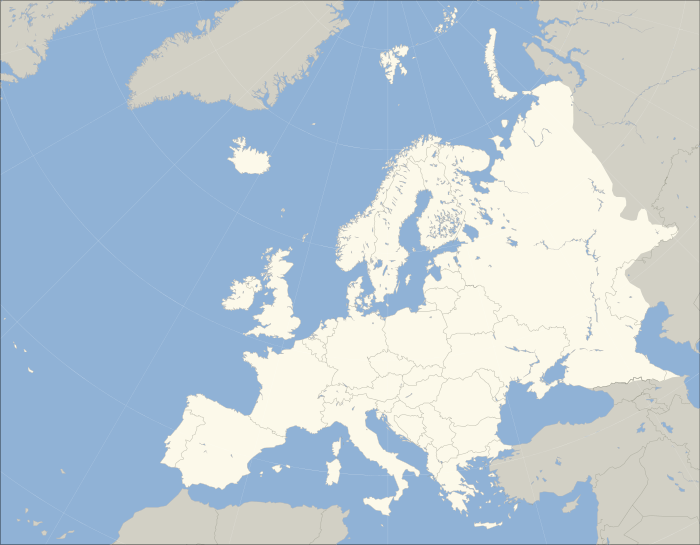List of European countries by area
Below is a list of most states in Europe, in order of geographical area. Europe's total geographical area is about ten million square kilometres.[1]
Some states (marked *) are only partially located in Europe. Those are ranked according to the size of their European part only.
The list includes only sovereign states. Therefore, for example the United Kingdom is included in place of the four individual home nations.
Inland water is included in area numbers.
European states by area (top 12).
| Rank | State | Total area (km²) | Total area (sq mi) | Notes |
|---|---|---|---|---|
| 1 | 3,972,400 | 1,533,800 | 17,098,242 km2 (6,601,668 sq mi) including Siberia[2] | |
| 2 | 603,628 | 233,062[3] | ||
| 3 | 551,695 | 213,011 | 643,801 km2 (248,573 sq mi) when the overseas departments are included. | |
| 4 | 498,511 | 192,476 | 505,990 km2 (195,360 sq mi) when the Canary Islands, Ceuta and Melilla are included.[4] | |
| 5 | 450,295 | 173,860 | ||
| 6 | 385,178 | 148,718 | This includes Svalbard and Jan Mayen.[5] | |
| 7 | 357,386 | 137,988[6] | ||
| 8 | 338,145 | 130,559 | ||
| 9 | 312,685 | 120,728 | ||
| 10 | 301,338 | 116,347 | ||
| 11 | 242,495 | 93,628 | Not including British Overseas Territories. | |
| 12 | 238,397 | 92,046 | ||
| 13 | 207,600 | 80,200 | ||
| 14 | 148,000 | 57,000 (est.) | (Territory West of Ural River is counted as Europe) 2,724,902 km2 (1,052,091 sq mi) including Asian part | |
| 15 | 131,940 | 50,940 | ||
| 16 | 110,994 | 42,855 | ||
| 17 | 102,775 | 39,682 | ||
| 18 | 93,030 | 35,920 | ||
| 19 | 91,568 | 35,355 | ||
| 20 | 83,858 | 32,378 | ||
| 21 | 78,866 | 30,450 | ||
| 22 | 77,453 | 29,905 | 88,361 km2 (34,116 sq mi) including Kosovo | |
| 23 | 70,273 | 27,133 | ||
| 24 | 65,300 | 25,200 | ||
| 25 | 64,589 | 24,938[7] | ||
| 26 | 56,594 | 21,851 | ||
| 27 | 51,129 | 19,741 | ||
| 28 | 49,036 | 18,933 | ||
| 29 | 45,339 | 17,505 | ||
| 30 | 44,493 | 17,179 | This includes Faroe Islands; 2,210,579 km2 (853,509 sq mi) including Greenland | |
| 31 | 41,290 | 15,940 | ||
| 32 | 41,198 | 15,907 | Excluding Caribbean Netherlands, Aruba, Curacao and Sint Maarten. | |
| 33 | 33,846 | 13,068 | ||
| 34 | 30,510 | 11,780 | ||
| 35 | 29,843 | 11,522 | Sometimes considered part of Asia | |
| 36 | 28,748 | 11,100 | ||
| 37 | 25,713 | 9,928 | ||
| 38 | 23,764 | 9,175 | 783,562 km2 (302,535 sq mi) including Asian part | |
| 39 | 20,273 | 7,827 | ||
| 40 | 13,812 | 5,333 | ||
| 41 | 10,887 | 4,203 | Partially recognised state | |
| 42 | 9,251 | 3,572 | A Mediterranean island near Turkey in the Middle East, it is a member of the EU[8] | |
| 43 | 6,960 | 2,690 | 86,600 km2 (33,400 sq mi) including Asian part | |
| 44 | 2,586 | 998 | ||
| 45 | 2,428 | 937 | 69,700 km2 (26,900 sq mi) including Asian part | |
| 46 | 468 | 181 | ||
| 47 | 316 | 122 | ||
| 48 | 160 | 62 | ||
| 49 | 61 | 24 | ||
| 50 | 2.02 | 0.78 | ||
| 51 | 0.44 | 0.17 |
Definition
Europe and Asia are contiguous with each other and thus the exact boundary between them is not clearly defined, and often follows historical, political, and cultural definitions rather than geographical.

Atlantic
Ocean
Clickable map of Europe, showing one of the most commonly used continental boundaries[9]
Legend: blue = Contiguous transcontinental states; green = Sometimes considered European but geographically outside Europe's boundaries.
See also
References
- "Map and Details of all 7 Continents". WorldAtlas. Retrieved May 4, 2019.
- "The World Factbook - Central Asia - Russia". CIA World Factbook. Central Intelligence Agency. Retrieved 3 May 2019.
- "Ukraine". United Nations in Ukraine. Retrieved 2020-02-14.
- "Entorno físico y medio ambiente" (PDF). Instituto Nacional de Estadística. p. 10. Retrieved 4 August 2019.
- "Updated land cover figures". ssb.no. Retrieved 2015-11-21.
- "Fläche und Bevölkerung". www.statistikportal.de (in German).
- "Latvia country profile". 29 March 2019. Retrieved 2019-10-28 – via www.bbc.com.
- "Europe :: Cyprus — The World Factbook - Central Intelligence Agency". www.cia.gov. Retrieved 2020-04-28.
- The map shows one of the most commonly accepted delineations of the geographical boundaries of Europe, as used by National Geographic and Encyclopædia Britannica. Whether countries are considered in Europe or Asia can vary in sources, for example in the classification of the CIA World Factbook or that of the BBC. Certain countries in Europe, such as France, have territories lying geographically outside Europe, but which are nevertheless considered integral parts of that country.